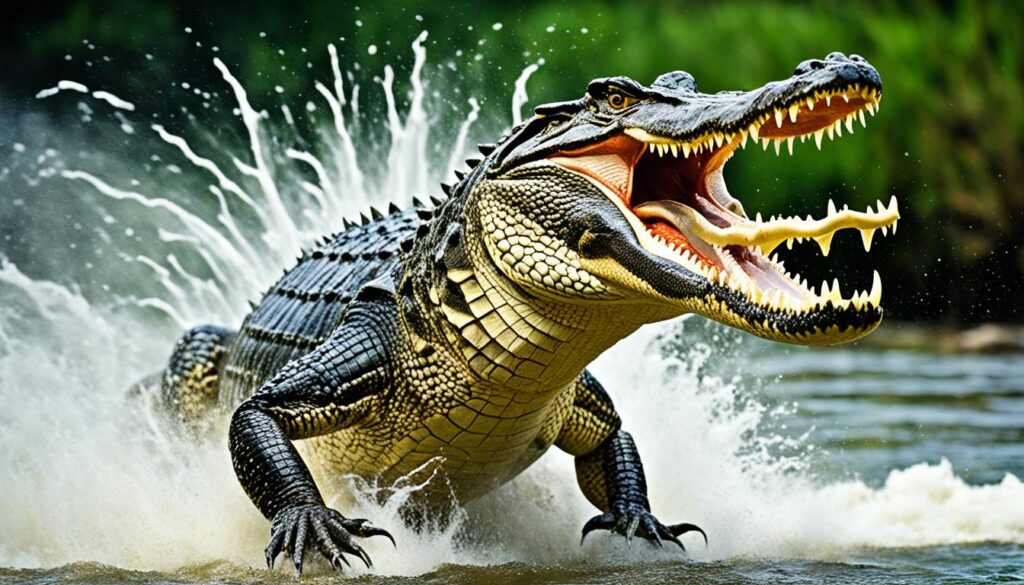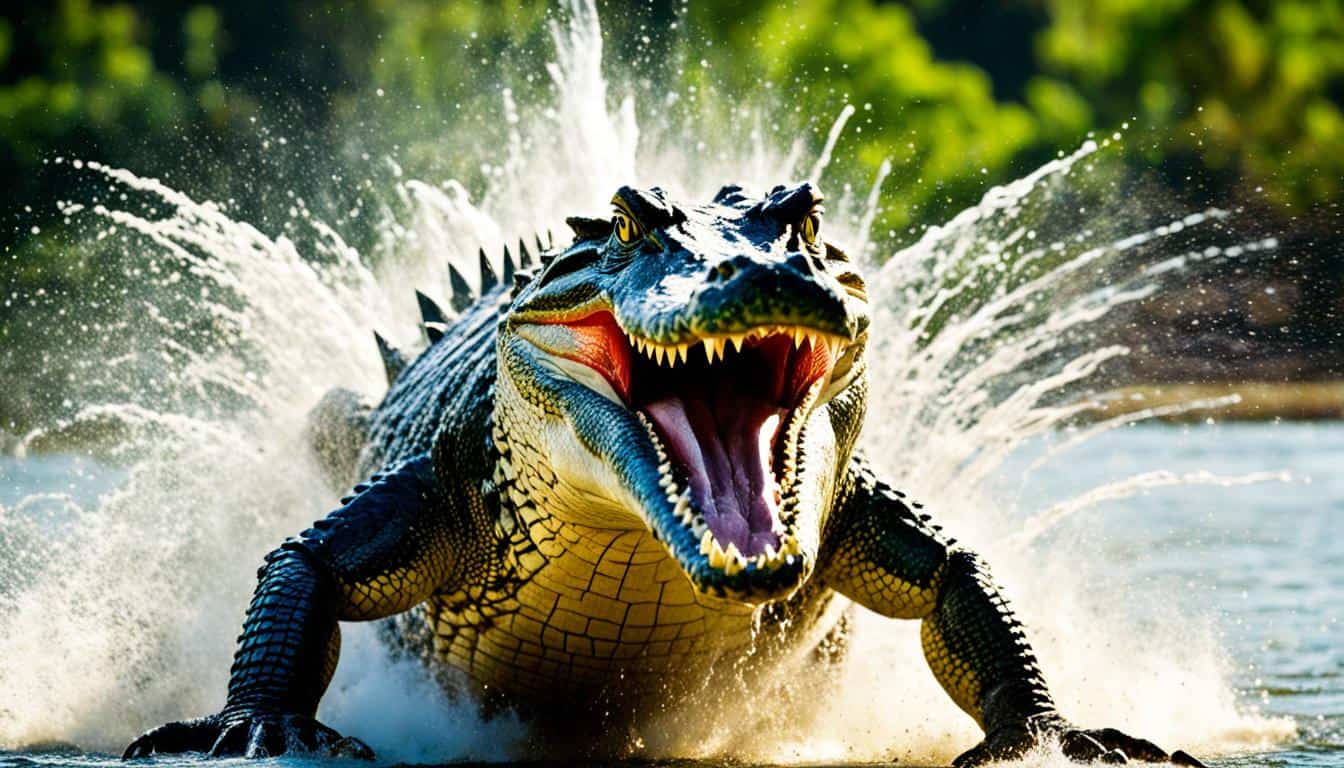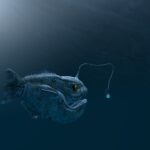Let’s dive into how fast crocodiles can run and what makes them so remarkable. Saltwater crocodiles, in particular, can move quickly on land and in water. They are known as some of the fastest reptiles in nature. Despite their slow image, they can suddenly speed up with incredible force.
This article will explore the true speed of crocodiles and what helps them move so fast. You’ll learn about the factors that make their speed possible.
The Amazing Speed of Crocodiles
Crocodiles may seem slow and lazy, but they are actually quite fast. The crocodile movement speed is amazing, especially the saltwater crocodile. They can run so fast, it’s surprising.
It’s important to understand how crocodiles sprint. They use quick bursts of speed to catch prey or get away from danger. Their speed shows how agile they are, even though they look big and heavy.
The crocodile velocity on land shows how well they fit into their environment. They move fast whether they’re through thick plants or across open areas. Knowing how fast they can move helps us see them in a new light and appreciate their survival skills.
| Species | Max Speed on Land (mph) | Max Speed in Water (mph) |
|---|---|---|
| Saltwater Crocodile | 12 | 15 |
| American Crocodile | 10 | 20 |
| Nile Crocodile | 9 | 18 |
How Fast Can Crocodiles Run?
Crocodiles are known for their strong bodies and fast movements. They can run up to 11 km/h (about 7 mph) in short bursts. This speed helps them move quickly when needed.
Comparative Speed with Other Reptiles
It’s interesting to see how fast crocodiles run compared to other reptiles. Here’s how they compare:
| Reptile | Running Speed (km/h) |
|---|---|
| Crocodile | 11 |
| Alligator | 15 |
| Komodo Dragon | 20 |
This table shows how crocodiles compare to other reptiles in speed. They are a bit slower than alligators but still quite fast for reptiles.
Understanding Crocodile Sprinting Ability
Crocodiles have amazing sprinting skills thanks to their muscles and body design. They are built for quick, powerful movements. This helps them hunt or escape quickly.
When a crocodile suddenly runs fast, its body uses strength and momentum well. This shows how important their body structure is for their speed.
Crocodile Running Speed: The Facts
The average crocodile can run at about 11-13 km/h (7-8 mph) for short distances. This speed is crucial for catching prey or getting away from danger.
Knowing how fast crocodiles run helps us understand their hunting ways. Their burst speed lets them move swiftly, even though they’re big. But, they’re not made for running long distances. They get tired easily and can’t keep up a fast pace for a long time.
Here’s a look at how crocodile speed compares to other reptiles:
| Reptile | Top Running Speed (km/h) | Top Running Speed (mph) | Notes |
|---|---|---|---|
| Crocodile | 11-13 | 7-8 | Short busts, not sustained. |
| Komodo Dragon | 20-24 | 12-15 | Can maintain speed over moderate distances. |
| Chameleon | 0.05-0.1 | 0.03-0.06 | Very slow, excels in climbing. |
| Lizard (Common) | 15-20 | 9-12 | Fast accelerators but not long-distance. |
The Physical Attributes Influencing Crocodile Speed
The physical traits of crocodiles are key to their fast speeds. Knowing how their body and muscles help them sprint is fascinating. It shows how they can move so quickly.
Body Structure and Its Role in Movement
Crocodiles have a body made for fast, short sprints. Their strong limbs help them push off the ground. Their streamlined shape cuts through the air with less resistance.
This design lets them speed up quickly for hunting or escaping danger. Their strong legs and flexible joints make moving fast on land easy for them.
Muscle Composition and Energy Use
The muscles of crocodiles are key to their fast speed. They have many fast-twitch muscle fibers for quick strength. These muscles work fast, helping crocodiles reach top speed quickly.
They also use their metabolism to save energy. This lets them speed up fast when needed. Their mix of power and endurance makes their speed during short sprints amazing.

Crocodile Velocity on Land
Crocodiles are amazing predators with special moves on land. They can run really fast in short bursts, making them stand out. Let’s explore what makes their sprinting skills so unique and what limits them.
Short Bursts vs. Sustained Speed
Watching a crocodile in the wild shows how their speed changes with the situation. They’re not made for long runs, but they’re great at short sprints. This helps them catch food or get away from danger fast. They save energy, so they can’t keep up a high speed for a long time.
Here are some important facts about crocodile speed on land:
- Crocodiles can hit speeds of up to 12 to 14 miles per hour in short runs.
- Their speed comes from quick energy bursts, not staying fast for a long time.
- These short sprints usually last just a few seconds before they slow down.
Environmental Factors Impacting Speed
Understanding how fast crocodiles can run means looking at the environmental factors that affect their speed. The terrain greatly changes how fast they can move. For example, they can run fast on flat land but slow down on rocky ground. Their speed depends a lot on their environment.
The Importance of Terrain
The terrain affects not just how fast crocodiles move but also their hunting and survival. In places with lots of obstacles, they move quietly and carefully instead of running fast. This shows how important their environment is for their speed and survival.
Temperature and Its Effects on Movement
Temperature is key to how fast crocodiles move. Since they can’t control their body heat, they need warmth to stay active. When it’s warm, they move faster. But when it’s cold, they move slower. This shows how temperature changes their speed and agility.
FAQ
How fast can crocodiles run on land?
Crocodiles can run up to 11-13 km/h (7-8 mph) on land. This speed helps them catch prey or get away from danger.
What factors influence crocodile speed?
Many things affect how fast crocodiles can move. Their body shape, muscle type, the ground they’re on, and the temperature matter a lot. They move best on flat ground and when it’s warm.
How does crocodile speed compare to alligators?
Both crocodiles and alligators can move fast. But sometimes, alligators might be a bit quicker. This shows how these reptiles compete with each other.
Do crocodiles maintain their running speed over long distances?
No, crocodiles can’t keep up their top speed for a long time. They get tired quickly. Their speed is best used for short sprints.
How do muscle fibers affect crocodile sprinting ability?
Crocodiles have fast-twitch muscle fibers. This lets them speed up quickly and sprint fast when they need to.
Are crocodiles as fast in water as they are on land?
Yes, crocodiles move fast in water too. They use their streamlined bodies to swim quickly. But they’re usually faster in short sprints on land.
How does temperature impact crocodile movement speed?
Crocodiles move faster in warm temperatures. Being ectothermic means their speed and agility increase when it’s warmer.
What role does terrain play in crocodile speed?
Crocodiles move fastest on flat, clear ground. But rough or uneven surfaces can slow them down and make it harder for them to sprint.







